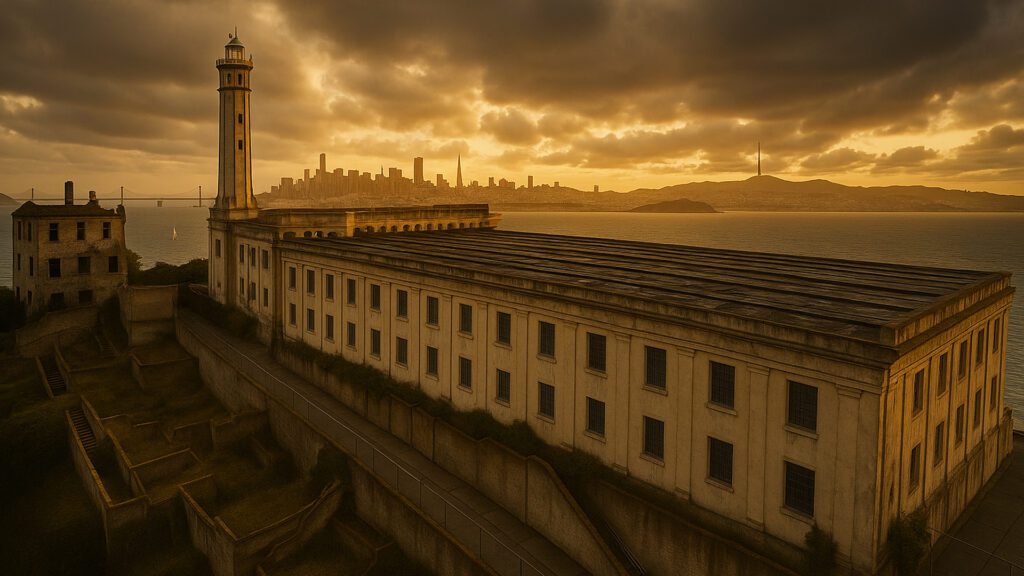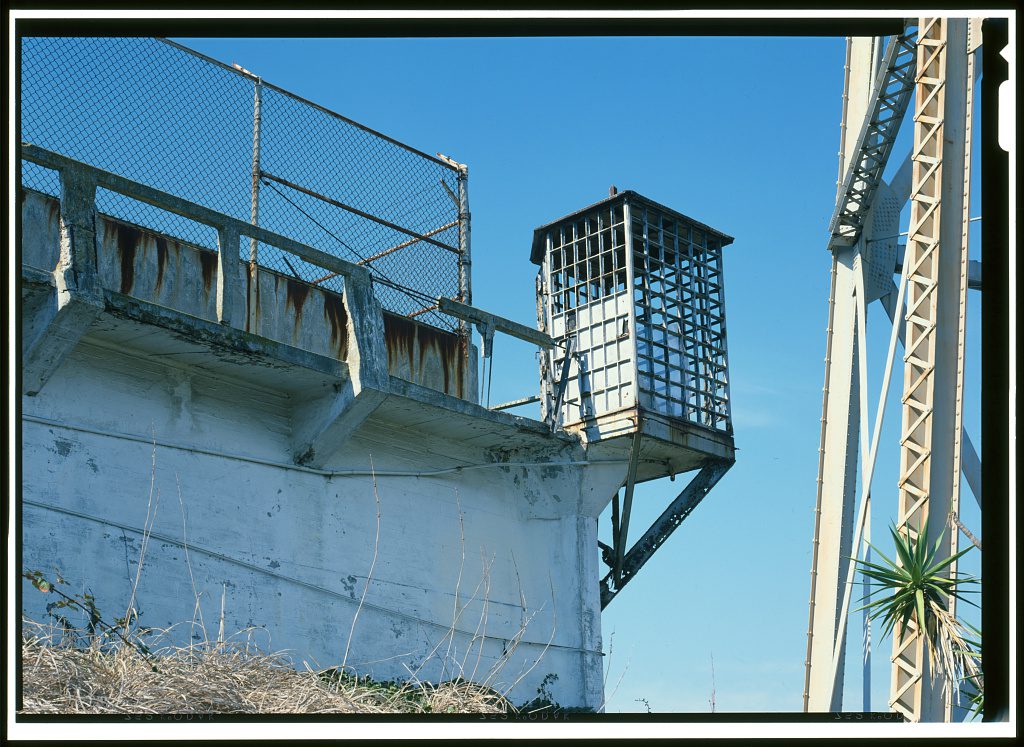President Donald Trump ordered the reopening of Alcatraz as a prison to “house America’s most ruthless and violent offenders.”
Similar concern for law and order motivated officials to move 221 convicts considered the “worst of the worst” to the island called the “Rock” in 1934.
In the midst of the Administration’s DOGE efforts spearheaded by Elon Musk to slash wasteful spending, raising Alcatraz from rust and ruin would likely cost billions of dollars.
Congress considered closing the expensive prison in 1949. Five years later, the federal prison director warned that the “Rock” was caving in.
A Fortress Forged in Fear
Alcatraz didn’t begin as a prison. It began as a coastal fort in 1850, designated by President Millard Fillmore.
By the Civil War, it was armed with 111 cannons aimed at threats that never came.
A Military Prison for Deserters & Native American Resistors
When the U.S. Army transformed it into a military prison in 1861, they quickly realized geography was more effective than any guard dog.
But its most potent weapon wasn’t military. It was isolation. Surrounded by bone-chilling swift currents and razor-sharp rocks, the island dared even the most desperate to swim for freedom.
Compared To Devil’s Island French Penal Colony
In 1934, the fortress became the nation’s first supermax federal prison. There was no illusion about rehabilitation. It was meant to remove what Warden James A. Johnston characterized as the “worst of the worst” from the nation’s prisons.
Two hundred twenty-one convicts arrived, among them Al Capone in a sealed rail car. FBI Director J. Edgar Hoover had named Capone “Public Enemy Number One”. His reputation was reduced to number AZ 85 at Alcatraz.
Officials designed the prison to be escape-proof. Hardened steel, floodlights, watchtowers, and an armed perimeter with machine guns in the towers ensured that the island itself became the wall. Inmates passed through the mess hall under tight supervision. Even their silverware was counted after every meal.
Swift frigid currents provided a moat around the island that swallowed escapees who tried to swim across it.
The Last Great Escape
Despite the mythology, Alcatraz wasn’t invincible. A few inmates tested its limits—most famously Frank Morris and the Anglin brothers in 1962.
They cleverly made plaster heads with human hair to fool guards that they were asleep in their cells.
They tunneled through crumbling concrete with crude tools and vanished into the bay on a raft made of raincoats.
A seventeen-year investigation by the FBI never confirmed if they survived, but their disappearance shattered the illusion of complete security.
Rust & Ruin
The ocean salt had eaten through its plumbing and corroded its walls.
The same isolation that once made Alcatraz an ideal prison made it financially unsustainable. Everything—food, fuel, supplies, and nearly a million gallons of fresh water each week had to be delivered by boat.
In the end, the government ran the numbers and reached a simple conclusion: it was cheaper to build something new than to keep Alcatraz afloat.
Alcatraz was closed after 29 years of incarcerating the nation’s most dangerous inmates.
According to the Bureau of Prisons, between 1934 and 1963, thirty-six men, including two who tried to escape twice, were involved in fourteen separate escape attempts. Of these, twenty-three were caught, six were shot and killed during their escape, and two drowned.
After the prison closed on March 21, 1963, it was abandoned. In 1969, a group of Native American activists occupied Alcatraz for 19 months to call attention to the plight of their tribes.
The Allure of Alcatraz
Alcatraz reopened to the public in 1973 and remains a park, museum, and bird sanctuary operated by the National Park Service. It was listed as a National Historic Landmark in 1986.
It ranks among San Francisco’s top attractions, drawing nearly one and a half million tourists annually.
Should We Reopen A Relic?
You can hear the full story about the history of Alcatraz on my True Crime Reporter® Podcast episode, The Rock: Alcatraz’s Chilling True Crime History. I interviewed Christina Vidovich, a recent tourist who visited Alcatraz with her young son. Twice, she’s walked along its decaying cell blocks.
“It’s absolutely ludicrous,” she said when I asked what she thought about the idea of reopening the prison. “There’s too much work that needs to be done to make it inhabitable, even for the worst criminal. It still smells like an old institution—like something from a bad HGTV rescue show.”
She pointed out that the plumbing is gone. The beds are rusted. Entire sinks have been removed. What’s left is a hollow shell—an empty stage dressed in shadows and steel.
“It’s fascinating as history,” she told me. “But not as a place to hold people again. It’s simply not fit for that.”
Alcatraz of the Rockies
Today, the federal prison system locks away its most dangerous offenders inside ADX Florence in Colorado—the nation’s only supermax, known as the “Alcatraz of the Rockies.”
I’ve walked the echoing corridors of Texas administrative segregation units, which are prisons inside prisons.
The isolation is so complete, even Alcatraz would blink.
The Rock is a ghost of its past.
Could this relic of punishment past ever serve its purpose again?
Or is the idea of reopening Alcatraz just a fantasy clinging to rusted bars and fading myths?
This is Robert Riggs, reporting for the True Crime Reporter® Podcast.
Read the Alcatraz Warden’s “Rap Sheets” about its most Infamous inmates.
PLEASE SUPPORT MY WORK
Click here to purchase my “Texas Crime Stories” audiobook. It downloads into your podcast app.
Click here to purchase the Paperback & Kindle editions on Amazon.
Schedule me to speak at your social meeting or corporate event.
My presentation, “Evil Walks Among Us,” features stories about serial killers and notorious criminals and personal safety tips.
Step into the storied halls of the Texas Prison Museum and uncover the gripping tales of infamous inmates, daring escapes, and the history of justice in the Lone Star State.









